Lexus ES: Hybrid/EV Battery Control System Over Temperature (P30004B)
DESCRIPTION
The battery ECU assembly monitors the temperature of the HV battery to detect if it becomes excessively high.
| DTC No. | Detection Item | DTC Detection Condition | Trouble Area | MIL | Warning Indicate |
|---|---|---|---|---|---|
| P30004B | Hybrid/EV Battery Control System Over Temperature | The battery ECU assembly detects a HV battery cooling system error signal. (1 trip detection logic) |
| Does not come on | Master Warning Light: Comes on |
HINT:
The normal HV battery temperature is 60°C (140°F) or less.
Related Data List| DTC No. | Data List |
|---|---|
| P30004B |
|
CONFIRMATION DRIVING PATTERN
HINT:
After repairs have been completed, clear the DTCs and then check that the vehicle has returned to normal by performing the following All Readiness check procedure.
Click here .gif)
- Connect the Techstream to the DLC3.
- Turn the power switch on (IG) and turn the Techstream on.
- Clear the DTCs (even if no DTCs are stored, perform the clear DTC procedure).
- Turn the power switch off and wait for 2 minutes or more.
- Turn the power switch on (IG) and turn the Techstream on.
- Drive the vehicle for approximately 10 minutes according to the freeze frame data items "Vehicle Speed", "Hybrid/EV Battery Temperature 1 to 6", "Hybrid/EV Battery Cooling Fan Intake Air Temperature 1", "Ambient Temperature" and "Hybrid/EV Battery Current".
- Enter the following menus: Powertrain / HV Battery / Utility / All Readiness.
-
Check the DTC judgment result.
HINT:
- If the judgment result shows NORMAL, the system is normal.
- If the judgment result shows ABNORMAL, the system has a malfunction.
- If the judgment result shows INCOMPLETE or N/A, perform driving pattern again.
CAUTION / NOTICE / HINT
CAUTION:
-
Before the following operations are conducted, take precautions to prevent electric shock by turning the power switch off, wearing insulated gloves, and removing the service plug grip from HV battery.
.png)
- Inspecting the high-voltage system
- Disconnecting the low voltage connector of the inverter with converter assembly
- Disconnecting the low voltage connector of the HV battery
-
To prevent electric shock, make sure to remove the service plug grip to cut off the high voltage circuit before servicing the vehicle.
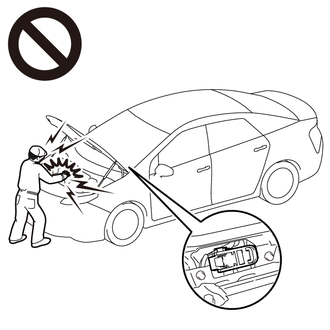
-
After removing the service plug grip from the HV battery, put it in your pocket to prevent other technicians from accidentally reconnecting it while you are working on the high-voltage system.
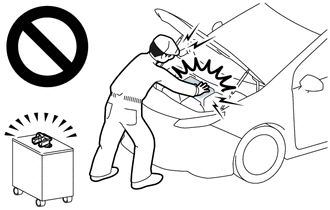
-
After removing the service plug grip, wait for at least 10 minutes before touching any of the high-voltage connectors or terminals. After waiting for 10 minutes, check the voltage at the terminals in the inspection point in the inverter with converter assembly. The voltage should be 0 V before beginning work.
Click here
.gif)
.gif)
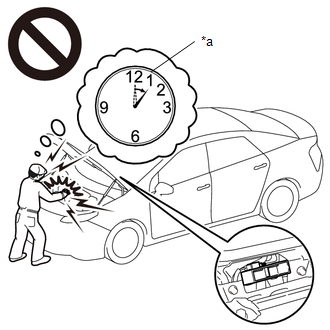
*a
Without waiting for 10 minutes
HINT:
Waiting for at least 10 minutes is required to discharge the high-voltage capacitor inside the inverter with converter assembly.
-
Make sure to insulate the high-voltage connectors and terminals of the HV battery with insulating tape after removing it.
If the HV battery stored without insulating the connectors and terminals, electric shock or fire may result.
-
When disposing of an HV battery, make sure to return it through an authorized collection agent who is capable of handling it safely. If the HV battery is returned via the manufacturer specified route, it will be returned properly and in a safe manner by an authorized collection agent.
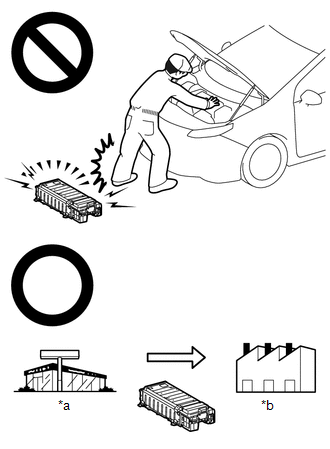
*a
Dealer
*b
Battery Collection Agent
- Accidents such as electric shock may result if the HV battery is disposed of improperly or abandoned. Therefore, make sure to return all HV batteries through an authorized collection agent.
-
Before returning the HV battery, make sure to perform a recovery inspection.
Click here
.gif)
-
Before returning the HV supply stack sub-assembly, make sure to perform a recovery inspection.
Click here
.gif)
- Make a note of the output DTCs as some of them may be necessary for recovery inspection of the HV battery and HV supply stack sub-assemblies.
-
After removing the HV battery, keep it away from water. Exposure to water may cause the HV battery to produce heat, resulting in a fire.
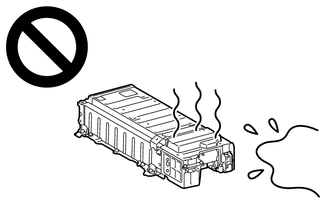
NOTICE:
After turning the power switch off, waiting time may be required before disconnecting the cable from the negative (-) auxiliary battery terminal. Therefore, make sure to read the disconnecting the cable from the negative (-) auxiliary battery terminal notices before proceeding with work.
Click here .gif)
.gif)
PROCEDURE
| 1. | CHECK DTC OUTPUT (HV BATTERY, HYBRID CONTROL) |
(a) Connect the Techstream to the DLC3.
(b) Turn the power switch on (IG).
(c) Enter the following menus: Powertrain / HV Battery and Hybrid Control / Trouble Codes.
(d) Check for DTCs.
Powertrain > HV Battery > Trouble Codes Powertrain > Hybrid Control > Trouble Codes| Result | Proceed to |
|---|---|
| "P30004B" only is output, or DTCs except the ones in the table below are also output. | A |
| DTCs of hybrid battery system in the table below are output. | B |
| DTCs of hybrid control system in the table below are output. | C |
| System | Relevant DTC | |
|---|---|---|
| Hybrid battery system | P060A47 | Hybrid/EV Battery Energy Control Module Monitoring Processor Watchdog / Safety MCU Failure |
| P060B49 | Hybrid/EV Battery Energy Control Module A/D Processing Internal Electronic Failure | |
| P060687 | Hybrid/EV Battery Energy Control Module Processor to Monitoring Processor Missing Message | |
| P0A8111 | Hybrid/EV Battery Cooling Fan 1 Circuit Short to Ground | |
| P0A8115 | Hybrid/EV Battery Cooling Fan 1 Circuit Short to Auxiliary Battery or Open | |
| P0A8196 | Hybrid/EV Battery Cooling Fan 1 Component Internal Failure | |
| P0A9B11 | Hybrid/EV Battery Temperature Sensor "A" Circuit Short to Ground | |
| P0A9B15 | Hybrid/EV Battery Temperature Sensor "A" Circuit Short to Auxiliary Battery or Open | |
| P0A9B1C | Hybrid/EV Battery Temperature Sensor "A" Voltage Out of Range | |
| P0A9B2A | Hybrid/EV Battery Temperature Sensor "A" Signal Stuck In Range | |
| P0AAC11 | Hybrid/EV Battery Air Temperature Sensor "A" Circuit Short to Ground | |
| P0AAC15 | Hybrid/EV Battery Air Temperature Sensor "A" Circuit Short to Auxiliary Battery or Open | |
| P0AC511 | Hybrid/EV Battery Temperature Sensor "B" Circuit Short to Ground | |
| P0AC515 | Hybrid/EV Battery Temperature Sensor "B" Circuit Short to Auxiliary Battery or Open | |
| P0AC51C | Hybrid/EV Battery Temperature Sensor "B" Voltage Out of Range | |
| P0AC52A | Hybrid/EV Battery Temperature Sensor "B" Signal Stuck In Range | |
| P0ACA11 | Hybrid/EV Battery Temperature Sensor "C" Circuit Short to Ground | |
| P0ACA15 | Hybrid/EV Battery Temperature Sensor "C" Circuit Short to Auxiliary Battery or Open | |
| P0ACA1C | Hybrid/EV Battery Temperature Sensor "C" Voltage Out of Range | |
| P0ACA2A | Hybrid/EV Battery Temperature Sensor "C" Signal Stuck In Range | |
| P0AE811 | Hybrid/EV Battery Temperature Sensor "D" Circuit Short to Ground | |
| P0AE815 | Hybrid/EV Battery Temperature Sensor "D" Circuit Short to Auxiliary Battery or Open | |
| P0AE81C | Hybrid/EV Battery Temperature Sensor "D" Voltage Out of Range | |
| P0AE82A | Hybrid/EV Battery Temperature Sensor "D" Signal Stuck In Range | |
| P0BC211 | Hybrid/EV Battery Temperature Sensor "E" Circuit Short to Ground | |
| P0BC215 | Hybrid/EV Battery Temperature Sensor "E" Circuit Short to Auxiliary Battery or Open | |
| P0BC21C | Hybrid/EV Battery Temperature Sensor "E" Voltage Out of Range | |
| P0BC22A | Hybrid/EV Battery Temperature Sensor "E" Signal Stuck In Range | |
| P0C3311 | Hybrid/EV Battery Temperature Sensor "F" Circuit Short to Ground | |
| P0C3315 | Hybrid/EV Battery Temperature Sensor "F" Circuit Short to Auxiliary Battery or Open | |
| P0C331C | Hybrid/EV Battery Temperature Sensor "F" Voltage Out of Range | |
| P0C332A | Hybrid/EV Battery Temperature Sensor "F" Signal Stuck In Range | |
| P306562 | Hybrid/EV Battery Temperature Sensor "Group 1" Signal Compare Failure | |
| P306A62 | Hybrid/EV Battery Temperature Sensor "Group 2" Signal Compare Failure | |
| Hybrid control system | P0A1F94 | Hybrid/EV Battery Energy Control Module Unexpected Operation |
(e) Turn the power switch off.
| B | .gif) | GO TO DTC CHART (HYBRID BATTERY SYSTEM) |
| C | .gif) | GO TO DTC CHART (HYBRID CONTROL SYSTEM) |
|
| 2. | REPLACE HYBRID VEHICLE CONTROL ECU |
Click here .gif)
.gif)
| NEXT | .gif) | REPLACE NO. 1 HV SUPPLY STACK SUB-ASSEMBLY AND NO. 2 HV SUPPLY STACK SUB-ASSEMBLY |

.gif)
